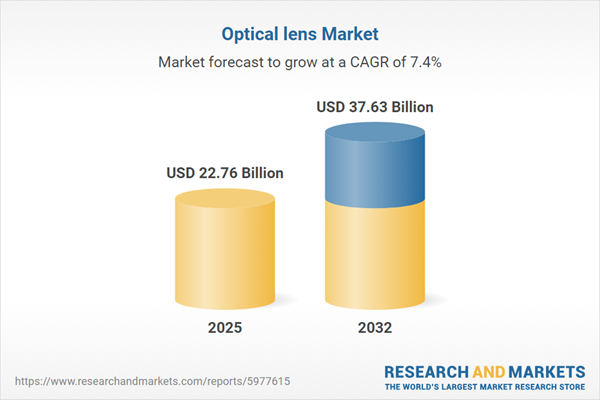Speak directly to the analyst to clarify any post sales queries you may have.
The optical lens market is navigating a period of transformative change, shaped by rapid technological advancement, evolving consumer demands, and shifting regulatory landscapes. Stakeholders face new challenges and opportunities as innovation accelerates and global market dynamics continue to evolve.
Market Snapshot: Growth Trajectory and Current Landscape
In 2024, the optical lens market was valued at USD 21.21 billion and is projected to rise to USD 22.76 billion by 2025. A compound annual growth rate (CAGR) of 7.42% is expected to propel the market to USD 37.63 billion by 2032, reflecting sustained demand across consumer, medical, and industrial applications. This growth is fueled by material innovation, increased customization, and regulatory pressures for safety and transparency. The market’s expansion underscores the sector’s critical role in addressing visual correction needs and driving technology adoption globally.
Scope & Segmentation: Diverse Markets and Strategic Opportunities
- Lens Types: Bifocal, Photochromic, Progressive (including computer optimized, premium, and standard progressive), Single Vision, and Trifocal lenses
- Material Types: Glass, High-Index plastics, Polycarbonate, Trivex, and other plastics
- Coating Types: Anti-Reflective (multi-layer and single-layer), Blue Light Filter, Hydrophobic, Scratch-Resistant, and UV Protection coatings
- End Users: Myopia, Hyperopia, Astigmatism, and Presbyopia correction
- Distribution Channels: E-Commerce, Eye Care Centers, Hospital Clinics, Optical Stores
- Price Ranges: Economy, Mid Range, Premium, Ultra Premium
- Applications: Ophthalmic, Camera optics, Industrial instrumentation
- Regional Coverage: Americas (including North America and Latin America), Europe, Middle East & Africa, Asia-Pacific
- Leading Companies Profiled: EssilorLuxottica S.A., Carl Zeiss AG, HOYA Corporation, Nikon Corporation, Seiko Optical Products, Rodenstock GmbH, Shamir Optical Industry, BBGR S.A., Transitions Optical, Younger Optics
Key Takeaways: Strategic Insights for Decision-Makers
- Investment in high-index plastics and hybrid materials is enabling lighter, thinner, and more durable eyewear solutions that effectively address evolving consumer preferences.
- Emerging technologies such as augmented reality integration and computer-optimized lens designs are unlocking new value propositions, particularly for digital device users and the premium segment.
- Regulatory frameworks are driving greater safety, transparency, and compliance, leading to increased strategic partnerships among lens producers, labs, and coating specialists.
- Personalization and sustainability are rising priorities, with brands adopting eco-friendly materials, solvent-free coatings, and advanced scanning techniques for custom fittings.
- The expanding influence of e-commerce and virtual try-on platforms is reshaping distribution, increasing the appeal of direct-to-consumer models and digital health integrations.
Tariff Impact: Supply Chains and Manufacturing Adaptation
The introduction of new tariffs in the United States in 2025 increased raw material and specialty component costs, compelling manufacturers to diversify sourcing and reconsider supply frameworks. Many leading producers have expanded regional partnerships or shifted production to offset increased imports and manage cost structures. These adaptations have driven supply chain resilience and prompted revisions in distribution margins and bundled service offerings as the industry adjusts to post-tariff realities.
Methodology & Data Sources
This research uses a mixed-methodology approach, combining primary interviews with executives, coating specialists, and distribution partners, and structured surveys targeting practitioners and end users. Qualitative findings are triangulated with secondary research from regulatory filings, industry reports, and proprietary databases. Statistical modeling and rigorous data validation ensure accurate insights and robust benchmarking.
Why This Report Matters: Strategic Value for Leadership
- Provides actionable insights to support portfolio realignment with high-growth segments and new technology adoption.
- Guides supply chain management decisions for mitigating risk, mastering new trade dynamics, and ensuring compliance.
- Supports go-to-market strategies through comprehensive assessment of segmentation, regional trends, and consumer behaviors.
Conclusion
This report equips industry leaders with a current, actionable view of the optical lens market. Strategic agility, technology investment, and targeted channel management will be key to unlocking future market opportunities.
Additional Product Information:
- Purchase of this report includes 1 year online access with quarterly updates.
- This report can be updated on request. Please contact our Customer Experience team using the Ask a Question widget on our website.
Table of Contents
3. Executive Summary
4. Market Overview
7. Cumulative Impact of Artificial Intelligence 2025
Samples

LOADING...
Companies Mentioned
The key companies profiled in this Optical lens market report include:- EssilorLuxottica S.A.
- Carl Zeiss AG
- HOYA Corporation
- Nikon Corporation
- Seiko Optical Products Co., Ltd.
- Rodenstock GmbH
- Shamir Optical Industry Ltd.
- BBGR S.A.
- Transitions Optical, Inc.
- Younger Optics, Inc.
Table Information
| Report Attribute | Details |
|---|---|
| No. of Pages | 197 |
| Published | October 2025 |
| Forecast Period | 2025 - 2032 |
| Estimated Market Value ( USD | $ 22.76 Billion |
| Forecasted Market Value ( USD | $ 37.63 Billion |
| Compound Annual Growth Rate | 7.4% |
| Regions Covered | Global |
| No. of Companies Mentioned | 11 |









